What are the capabilities of battery-electric police vehicles to serve in a patrol capacity? There is no simple answer due to variety of mission needs, agencies, and the availability of charging infrastructure.
Are Electric Patrol Vehicles Ready for Duty?
Typically, battery-electric police vehicles are mostly, at this point, used as administrative vehicles. What will it take for departments to deploy them as patrol units?
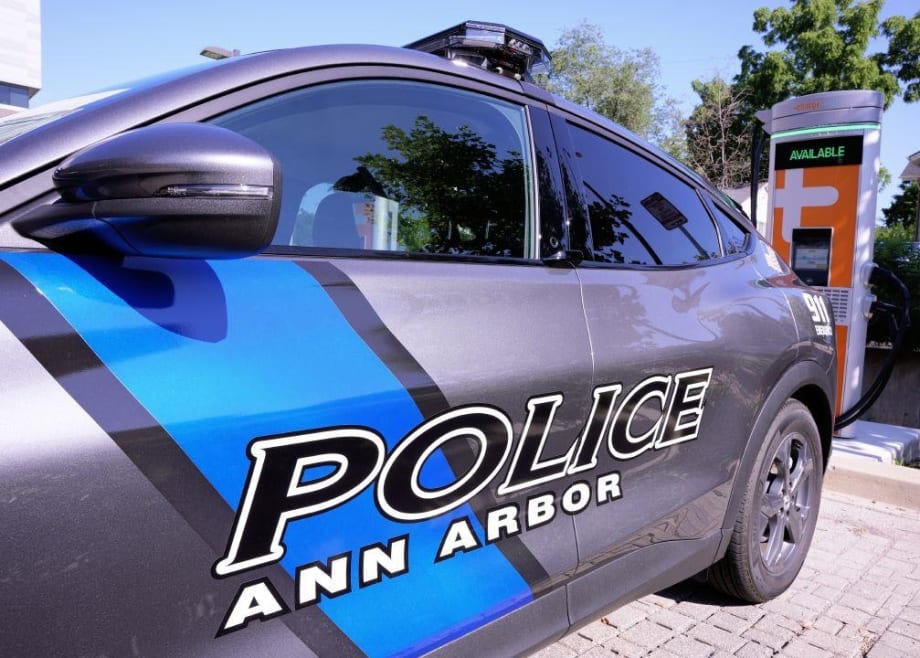
Although the Ann Arbor Police Department only uses battery-electric vehicles in administrative roles, its Ford Mustang Mach-E is serving as a recruitment aid to attract younger generation officers.
Ann Arbor Police Department
So, what role does a battery-electric patrol vehicle (BEV) now play, and how do they meet the needs of law enforcement? The vehicles are capable in some roles, but what else is needed?
The Michigan State Police Precision Driving Unit tests and evaluates patrol vehicles submitted by automakers (OEMs) and has tested BEVs for the past three years. This was the second year of testing for the Chevrolet Blazer EV PPV, a purpose-built BEV intended for patrol and pursuit. However, Ford did not send its Mustang Mach-E for evaluation this year.
The Mach-E was undergoing some updates that were not completed in time for the MSP evaluation, explains Lindsey Bertino, police brand marketing manager for Ford. However, the Mach-E was included in the West Coast evaluations that were done later in the year.
Battery-Electric vs. Gas
Michigan State Police started testing police vehicles in the 1950s, long before the modern era of battery-powered cars. When an OEM submits a BEV for testing, MSP gives it a full review the same as it does with the internal combustion engine (ICE) vehicles.
Lt. Nicholas Darlington, of the Michigan State Police Precision Driving Unit, shares his insights after time behind the wheel of both the Ford Mustang Mach-E and the Chevrolet Blazer EV PPV. Compared to ICE vehicles, in BEVs, the location of the battery lowers the center of gravity, and the cornering speeds are much greater than they are in the ICE counterparts.
“The one thing I think is notable in comparison to some of its ICE counterparts is when you start looking at acceleration, [BEVs] stand out. In terms of dynamic testing and vehicle handling, there is really the consistency in the times across all four drivers; that's where that vehicle stands out,” says Darlington. He describes both the Mach-E and the Blazer EV PPV as “super capable cars around the track.”
Does the added weight help maintain traction?
“I think so,” Darlington answers. “Where we do our dynamic testing at Grattan Speedway, it's a pretty taxing course for the cars that we're testing. You just don't see the wheel spin that you otherwise would in some of the ICE vehicles.”
Darlington says he is often asked if BEV patrol vehicles handle and drive like heavier vehicles. His answer is all anyone has to do is give it a try on an acceleration run. BEVs are known for lots of torque and quick acceleration. Yet, the weight of a BEV does not hamper how it handles.
“That BEV vehicle is capable of handling corner speeds at much higher speeds than that of the other vehicles. So, you're just not even getting that understeer or a push in a lot of the turns,” Darlington says.
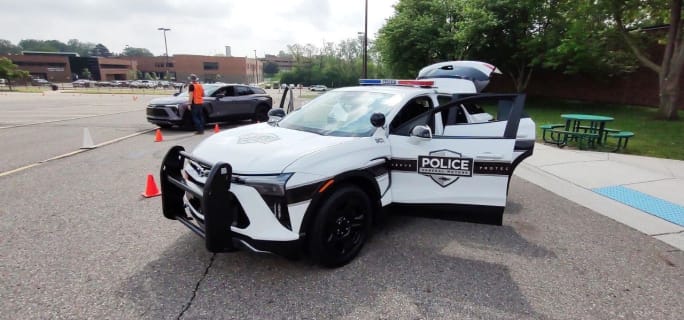
The Chevrolet Blazer EV PPV is a purpose-built battery-electric vehicle engineered for patrol. General Motors calls it pursuit-rated.
Wayne Parham
Transitioning Officers to BEVs
When a department adds BEVs to its fleet, what do officers need to learn before getting behind the wheel? Darlington says MSP is working to learn what can be done with applications of BEVs, policies, what shouldn’t be done, and what could be done better with ICE vehicles.
“I don't think that there's a lot of training that needs to take place outside of learning about charging and paying attention to the miles and things like that,” he explains.
MSP troopers, and likely other officers as well, are accustomed to using patrol units to push disabled vehicles out of the roadway in metro areas. Can that be accomplished with a BEV? Darlington thinks that would be no problem at all.
Can BEVs be used when an officer needs a PIT maneuver to end a pursuit?
“So even though I don't have any firsthand experience practicing any PITs yet with a BEV vehicle, I know with the torque and acceleration, that vehicle probably shouldn't have any problems pushing that vehicle, and even the increased weight of the vehicle is probably going to help it maintain traction as you're pushing into that vehicle and rotating it,” Darlington says.
With a heavier vehicle, is there an officer safety concern about single-vehicle crashes?
“The OEMs have done a fantastic job of building in some integrated safety features into the stability and traction control to help assist those officers who are behind the wheel and keep them safe,” he explains.
Ford’s Bertino says she is seeing agencies now that will include BEVs in EVOC training.
“They want to make sure that officers are trained on how to handle the vehicles and feel that they have a little bit more control than they do the traditional patrol vehicles, there's additional weight with the battery electric vehicle because of the battery pack, “Bertino says. “So, it's really interesting to see that.”
Size and Payload Challenges
One key challenge for departments adopting BEV patrol vehicles, Darlington points out, is payload capacity. In looking up the data on BEVs tested, he found the total payload capacity was only around 900 pounds.
“I think of the size of our troopers and the amount of equipment that we carry, I think that we would be critically close to, if not, overloading each one of those vehicles,” he says.
With some operations, two MSP troopers might be assigned to the same car. That could also double the amount of gear that is being carried as well.
“So, you start adding push bumpers, and computers, and center consoles, and patrol car lighting, and then all the equipment in the back, and the drawer organizers, and the flares and, fire extinguishers, Halligans, and all those things,” Darlington points out.
“As soon as you start overloading these vehicles, you know you're not going to have the same predictability in terms of safety,” the MSP lieutenant adds.
Darlington says MSP’s testing the BEVs has been an opportunity for OEMs to glean a lot of information, learn their BEVs capabilities, and gauge law enforcement interests.
“I think that as interest continues to grow and the engineers learn more on how they need to engineer a vehicle to meet our specific needs, which is very specific compared to that of the consumer market, I think that there might be other platforms a little more conducive to what police need in terms of size and capabilities of a car, a police vehicle,” Darlington shares.
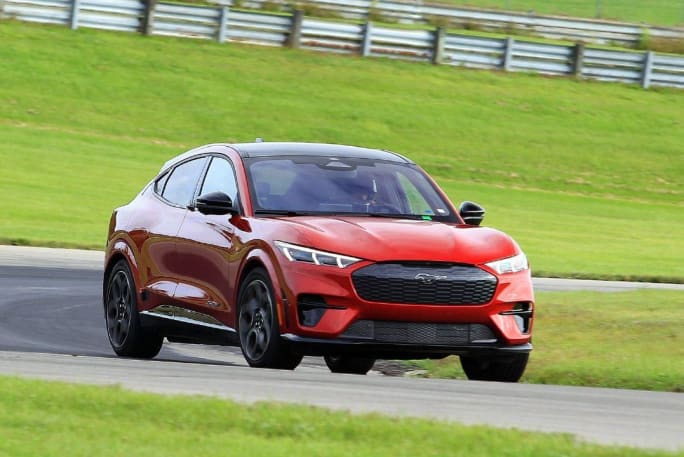
A trooper from the Michigan State Police Precision Driving Unit puts a 2024 Ford Mustang Mach-E through its paces during testing.
Blue Diamond Photography
First BEV for MSP
State security property officers located in downtown Lansing now have the agency’s first BEV, a 2024 Ford Mustang Mach-E. Darlington said the BEV is a good fit for that role, both in job requirement and location – meaning the Mach-E will serve in a good area for charging. The vehicle was delivered just a few weeks ago.
With a BEV of its own now, Darlington said MSP hopes to learn more about BEV tire wear, how long brakes last, what the realistic range will be, and more.
“Once the vehicle is under a load of power and MDC (mobile data compute) and patrol car lighting, and then how the ambient temperatures are going to affect that too,” says Darlington. “I'm just feel fortunate that we're finally going to get one and be able to get clean a lot of information from”
Darlington adds he has had conversations with several OEMs and potentially there could be some new BEV entrants in next year’s testing.
What Makes a Good Patrol Vehicle?
Many agencies look to the Precision Driving Unity and its research when considering patrol vehicles, whether battery-electric or ICE. Darlington says a lot of agencies, especially down south, are looking at how to use other vehicles to meet that sedan niche. Many of those agencies need patrol vehicles that can longer distances, like patrolling highways, and carry more payload and gear.
They are trying to fill the void left when the Dodge Charger ceased production, he says. He also says there's been some speculation amongst one of the OEMs that there might be a sedan available sometime in the near future. He was not free to elaborate.
“What I'm hoping, based on a lot of my conversations with the manufacturers and their engineers, is that we're going to really see police vehicles that are going to be capable of, carrying out the need of what we do in terms of size range, charging times” Darlington says. “That's what I'm hoping.”
Challenges for BEVs as Patrol Vehicles
The Avondale Estates Police Department in the Atlanta, Georgia, area is like many other departments – they have adopted fully-electric vehicles to some extent, but the BEVs only serve administrative functions.
Chief Harry Hess shares what keeps his department from adding BEVs to its patrol fleet. And, it’s not necessarily just about the vehicles.
In 2022 the department purchased three Mach-E SUVs. Those were assigned to the chief, the deputy chief, and a sergeant in investigations. Earlier this year, the department added a Ford F-150 Lightning, which the chief now drives. As a 6-foot-6-inch-tall chief, Hess said he was glad to take the truck over the smaller Mach-E.
“So, for admin personnel, I think the EV is a no brainer,” he said, explaining how the four fully-electric vehicles are saving the department about $250 a month. That is the difference between the charging cost and the cost of fuel they would have used in four ICE vehicles.
The biggest holdup in adding electric patrol vehicles is that the department assigns take-home patrol vehicles to officers. To be competitive in hiring, providing take-home cars is a must now, the chief of the small 14-officer department explains.
One concern is liability if a charging system ever caused a fire at an officer’s home. That, he says, is a small possibility, but still a possibility to be considered. Another concern is not every home’s electric system ready for a charger. The department learned that with a Mach-E assigned to an officer when the officer’s older home was not ready to handle the needs of a BEV charger.
“The panel could not support adding the EV charger. We had estimates of almost $8,000 to $10,000 just to upgrade the panel in his house to support that,” says Hess.
The officer lives in an area near a Level 3 charging location, so that was a solution. But, that meant the city had to pay him for work hours while he was waiting for the Mach-E to charge.
“The lack of infrastructure on the Level 3 chargers is the main hesitation in implementing them in patrol for us,” Hess says.
Another consideration is if an officer commutes home to find his area has a power outage following a storm. How would he charge the patrol vehicle to get it ready for the next shift? He likely would have battery capacity to get back to work, but then he might start a patrol shift at something like a 40% charge, the chief explains.
Then too, there is the road trip concern.
Officers travel for training, which is several hours away. In doing the drive in a BEV, Hess has found that once he gets out of Atlanta and takes the interstate south, there is only one public charging site.
Hess explained how on a trip to the Federal Law Enforcement Training Center near Brunswick he had to plan for one charging stop near Forsyth, then a second closer to Savannah. On that trip he spent 30 minutes charging at the first stop, then an hour at the second stop.
“What happens when there's no spare chargers?” Hess asks. “You have to wait for someone else to finish charging.”
BEVs as a Recruiting Tool
Agencies are finding that having BEVs can be a recruitment tool to help land younger officers, Bertino says.
“There's a shortage of officers right now, and we're starting to see a lot of agencies that are actually using the different electric vehicles as part of a part of the recruitment process,” she adds.
She says having a Mach-E out at recruiting events signals to younger-generation potential officers that the agency is taking a more EV-forward approach.
Police in Ann Arbor, Michigan, rely mostly on hybrid SUVs for patrol but the department has three Mach-Es serving in administrative roles. One is a marked unit that is used for public relations, including recruiting, and is promoted in a social media video.
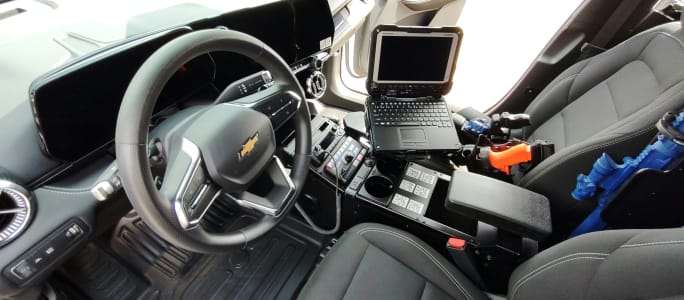
The BEV police vehicles are typically smaller than their internal combustion engine counterparts.
Wayne Parham
BEV Lessons Learned
The New York City Police Department (NYPD) was an early adopter of fully-electric police vehicles. In 2022, the NYPD purchased 148 Ford Mach-E GTs, with 40 designated as unmarked and 108 used for marked patrol, for $12 million.
Robert Martinez, who retired as deputy commissioner of support services for the NYPD at the end of 2020, said for a fully-electric vehicle to be used as a patrol vehicle there are two criteria it must meet.
First, it must meet the needs of the mission. Second, it must be safe.
While some agencies may struggle with payload limitations of a BEV patrol vehicle, in New York officers don’t carry as much gear, Martinez points out. Also, the NYPD patrol units did not get upfitted with a cage or push bumpers, only the light bar on top. So, they did not sacrifice payload because of upfits.
The Mach-E has found success as an NYPD patrol unit, but Mayor Bill de Blasio originally wanted the department to buy Tesla cars. The agency tested a Tesla Model 3 that was assigned to highway patrol.
“The biggest complaint with the Tesla is that it's nothing like a regular vehicle. The dashboard is in the center of the vehicle, not in front of the driver's eyes. So, when the cops were driving the vehicle, they had to constantly take their eyes off the road to see the dashboard,” Martinez says.
“We got the test of the Mach-E. I liked it,” says Martinez. “I was impressed with the vehicle. It operated like a regular vehicle.”
That basically is how NYPD ended up with Mach-E patrol vehicles instead of Tesla patrol vehicles.
However, now two-and-a-half years after the purchase, 20 to 25 Mach-E patrol units are not being used because there is no place to plug them in to charge, according to Martinez.
“If you ever come to Manhattan, you'll see that patrol cars park two or three blocks from the precinct, because there's no parking, even for a police car,” explains Martinez, adding that most of the precincts were built in the 1920 or 1930s.
Not an Easy Solution
Martinez points out that just like any other ICE or hybrid patrol vehicle, the fully-electric ones must meet the mission, however, across the country that mission has great diversity. A state trooper covers a lot of mileage, while in New York officers can extend battery range through regenerative braking because of heavy traffic and carry little gear.
Will an agency patrol with one officer and limited gear, or will there be two officers, such as in the case of field training or special details? Some communities have charging infrastructure, while others do not.
Eventually, most agencies could possibly find BEVs to be beneficial in administrative roles, but it will take the perfect mix of a variety of dynamics to make them practical for patrol. Only time, and location, will tell.
More Patrol

Police & Fire Championships Expands Athlete Eligibility
The US Police & Fire Championships is now open to all employees – sworn, civilian, administrative, technical, and support staff – who work directly for an eligible public safety agency.
Read More →
Tips for Watching the Hands
How can officers better “watch the hands”? Mike Willis, Law Enforcement National Training and Program Director for the US Deputy Sheriff's Association, shares some tips.
Read More →
10 Tips for Felony/High-Risk Stops
What steps can officers take to stay safer during felony or high-risk vehicle stops? Here are 10 tips from Mike Willis, Law Enforcement National Training and Program Director for the US Deputy Sheriff's Association.
Read More →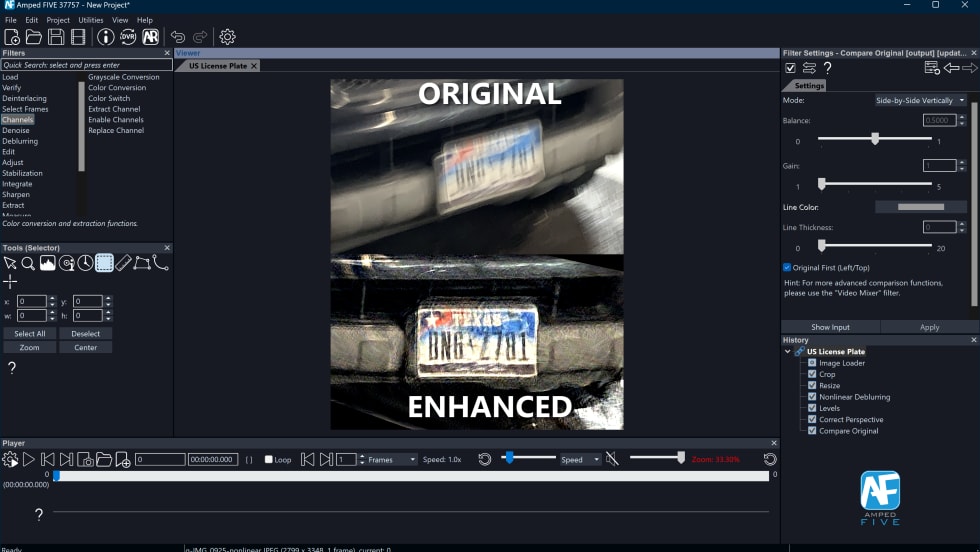
Amped Highlights Power Behind Amped FIVE Software
Amped FIVE empowers you to advance your investigations with confidence and precision, from the crime scene all the way to the courtroom.
Read More →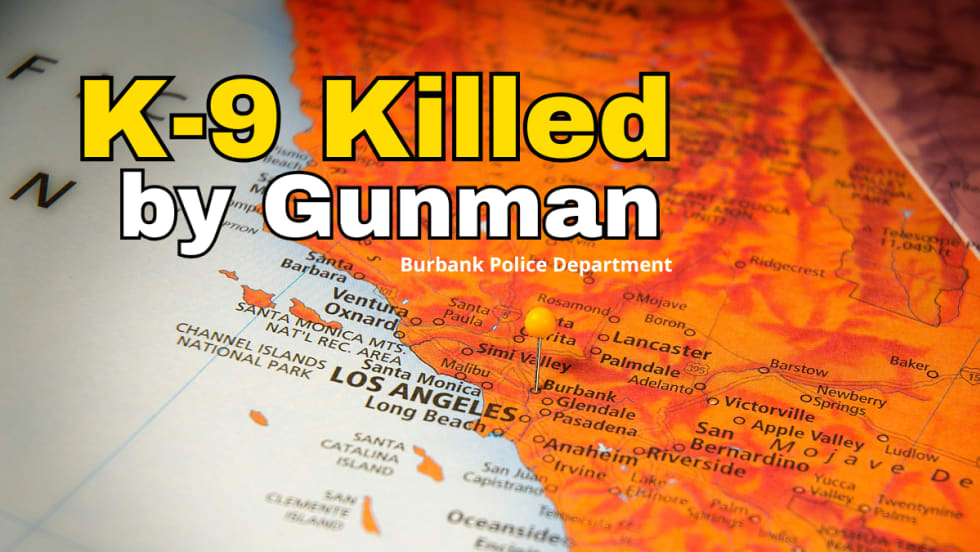
Police K-9 Killed, Suspect Dies in Shootout with Cops
A Burbank Police Department K-9 was fatally shot over the weekend by a passenger who fled on foot from a traffic stop. The armed suspect was killed in a shootout with officers.
Read More →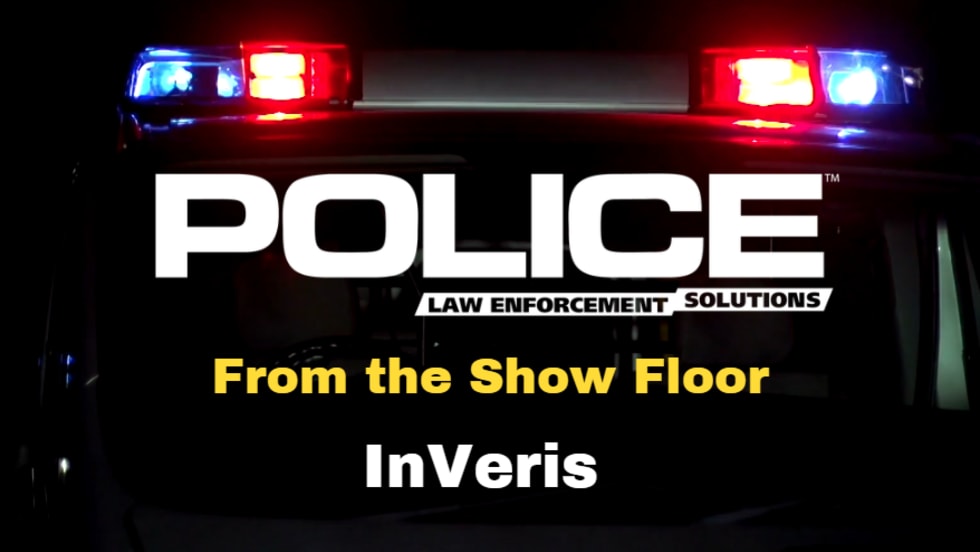
From the Show Floor: InVeris
In this video, learn about how InVeris provides training to law enforcement, including customized augmented reality scenarios. The augmented reality system can scan up to 10,000 square feet of real-life environments and create a curriculum based on those spaces.
Read More →
From the Show Floor: Polaris Government & Defense
Learn about Polaris Government & Defense in this video as POLICE visits their show booth to discover their side-by-sides and the advantages they provide for agencies.
Read More →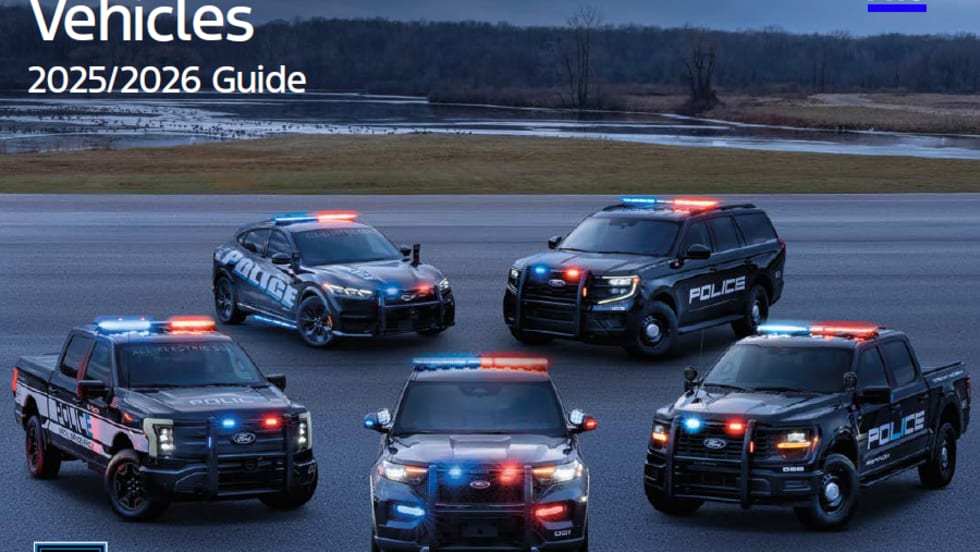
2026 Ford Pro™ Police & Special Service Vehicles Guide is Available for Download
Ford Pro™ meets the needs of law-enforcement agencies
Read More →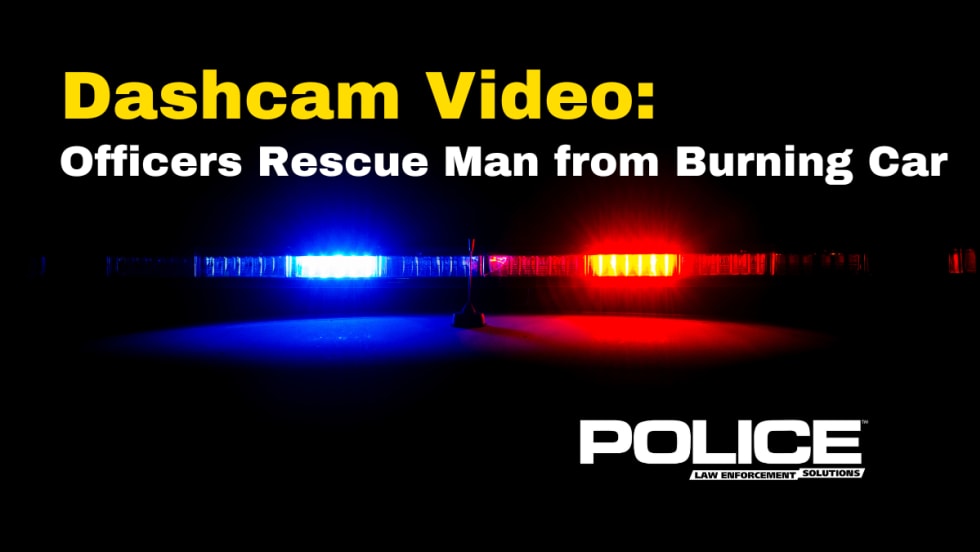
Dashcam Video Shows Officers Rescue Man from Burning Car
Dashcam video released by a New Jersey police department shows two of its officers rescuing an unconscious man from a burning car after a crash.
Read More →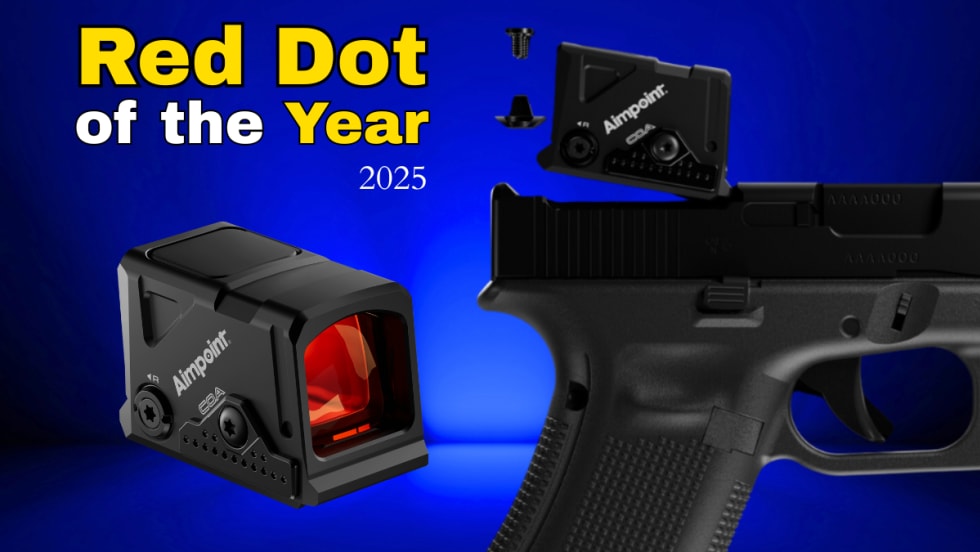
Aimpoint COA optic + A-CUT Named Red Dot of the Year
The Aimpoint COA optic + A-CUT system has been named Red Dot of the Year by Guns & Ammo magazine. The new optic system was introduced in January 2025.
Read More →

